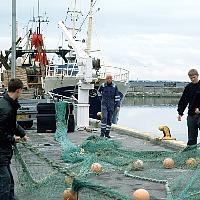(BRUSSELS) – Ahead of a 16-17 December Fisheries Council meeting, the European Commission on Thursday adopted its proposal for fishing opportunities in 2020 for 72 stocks in the Atlantic and the North Sea.
The fishing opportunities, or Total Allowable Catches (TACs), are quotas set for most commercial fish stocks in order to keep or restore healthy stocks, while allowing the industry to profit from fishing the highest amount of fish.
The proposals show that, for 32 stocks the fishing quota is either increased or remains the same; while for 40 stocks the quota is reduced.
“Over the past years, we have had a steady rise in the number of healthy stocks, and as a consequence also a steady rise in the profits of our fishing sector,” said Fisheries Commissioner Karmenu Vella: “This is the result of responsible management and continuous implementation efforts, primarily by our fishermen, who are the first ones to implement our conservation measures and also the ones to benefit most from increased yields. With such sustained commitment, 2020 will be another year of progress for Europe’s fisheries.”
The EU executive is proposing fishing opportunities at “maximum sustainable yield” (MSY) for the stocks with a full scientific assessment, and at “precautionary levels” for other stocks. The proposal follows the advice of the International Council for the Exploration of the Sea (ICES).
Sustainable fishing has made substantial progress in the EU, says the Commission: in 2019, 59 stocks are being fished at MSY levels, up from 53 in 2018 and compared to only 5 in 2009. This means that the fishing pressure on the stocks is limited to a level that will allow a healthy future for the fish stocks’ biomass, while taking into account socio-economic factors.
The Commission says it is working with EU Member States to support the fishermen in reaching the objective of fishing all stocks at sustainable levels by 2020, as set by the Common Fisheries Policy. As the size of some key fish stocks is increasing for instance, Haddock in the Celtic Sea and Sole in the Bristol Channel so has the profitability of the fishing sector, with an estimated 1.3 billion gross profit for 2019.
The proposal is to be submitted for discussion and decision by the EU Member States at the Fisheries Council on 16-17 December in Brussels, to be applied as of 1 January 2020.
In more detail, the Commission is proposing to limit the decrease of the TACs for Northern and Southern Hake to -20%, using the upper part of the MSY range according to the Western Waters multiannual plan. The stocks have a healthy biomass, therefore a limited reduction of the fishing pressure would suffice to keep the stocks in good shape, according to scientists.
The TAC for Haddock in the Celtic Sea could increase massively according to ICES advice (+100%), but the Commission proposes a 30% increase, using the lower part of the MSY range, in order to protect the vulnerable cod stock that is caught as a bycatch of haddock.
Where multiannual plans are not in place, the Commission has turned to the management strategies of the Advisory Councils, which have been assessed by ICES as sustainable. For example, for the southern Horse Mackerel, the Commission has proposed to follow the management strategy of the Pelagic Advisory Council, which recommends a reduction of the quota by 50%.
The Commission has also proposed safeguard measures to ensure that the amount of Cod and Whiting in the Celtic Sea recovers to safe levels. These measures consist of increased selectivity, closures and appropriate control to prevent illegal discards.
The Commission proposes to continue the quota exchange system for the by-catches. These are quotas set for stocks fished as by-catches in other healthy target fisheries. This system ensures that Member States with no quota for one of these by-catch stocks can continue fishing for other target stocks. The exact amounts for the by-catch TACs and their accompanying measures will be issued at a later stage, after ICES provides its scientific advice.
Since 1 January 2019, the landing obligation applies to EU fishing fleets: all catches of regulated commercial species (including by-catch) must be landed and counted against each Member State’s quota.In today’s proposal, the Commission has already deducted from the advised catches the amounts corresponding to the agreed exemptions to the landing obligation.
The proposal covers stocks managed by the EU alone and stocks managed in cooperation with third countries, such as Norway, or through Regional Fisheries Management Organisations (RFMOs). International negotiations for many of the stocks concerned are still ongoing and some further stocks are awaiting scientific advice. For these, the figures will be included at a later stage.


